2009 FORD F SERIES MOTORHOME AND COMMERCIAL CHASSIS brake light
[x] Cancel search: brake lightPage 59 of 136
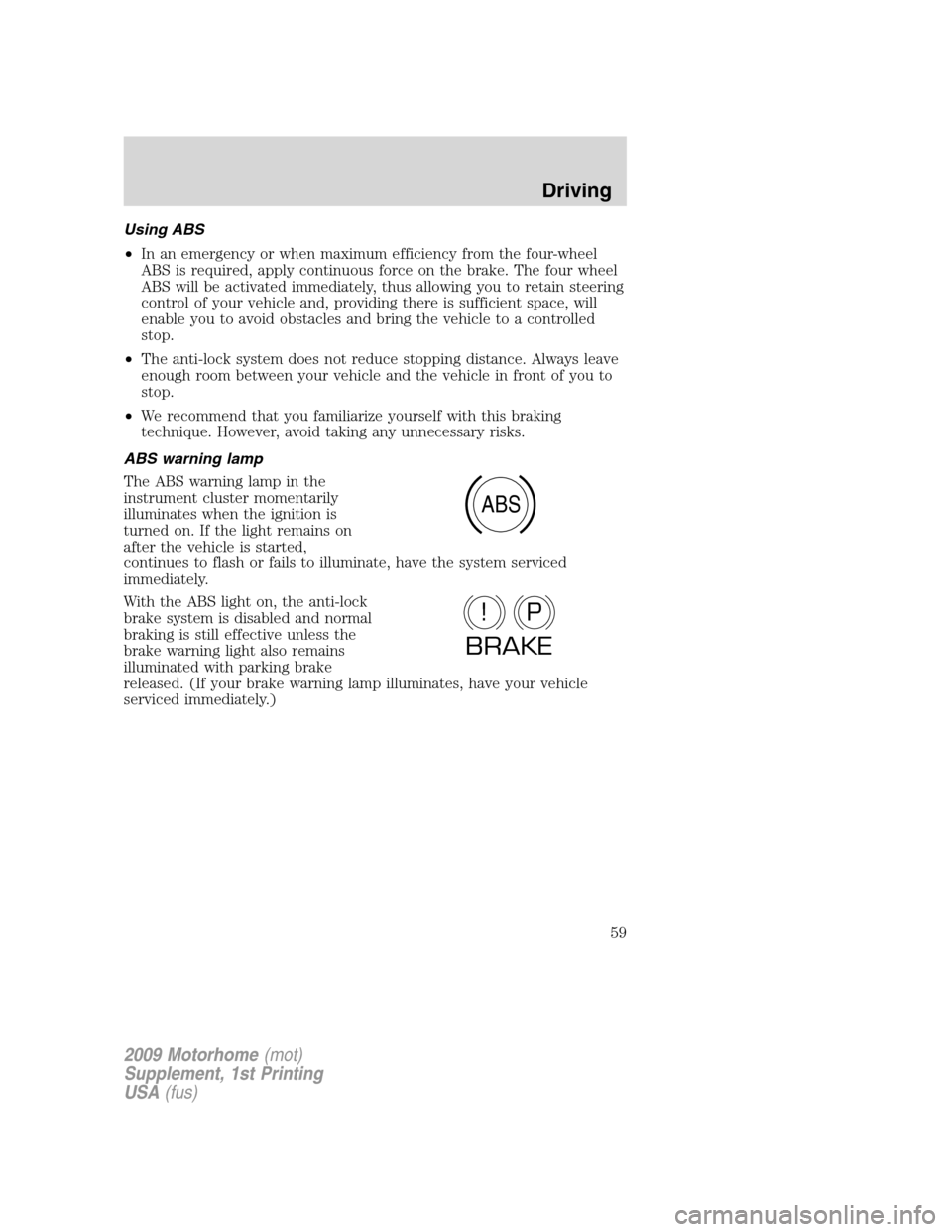
Using ABS
•In an emergency or when maximum efficiency from the four-wheel
ABS is required, apply continuous force on the brake. The four wheel
ABS will be activated immediately, thus allowing you to retain steering
control of your vehicle and, providing there is sufficient space, will
enable you to avoid obstacles and bring the vehicle to a controlled
stop.
•The anti-lock system does not reduce stopping distance. Always leave
enough room between your vehicle and the vehicle in front of you to
stop.
•We recommend that you familiarize yourself with this braking
technique. However, avoid taking any unnecessary risks.
ABS warning lamp
The ABS warning lamp in the
instrument cluster momentarily
illuminates when the ignition is
turned on. If the light remains on
after the vehicle is started,
continues to flash or fails to illuminate, have the system serviced
immediately.
With the ABS light on, the anti-lock
brake system is disabled and normal
braking is still effective unless the
brake warning light also remains
illuminated with parking brake
released. (If your brake warning lamp illuminates, have your vehicle
serviced immediately.)
ABS
P!
BRAKE
2009 Motorhome(mot)
Supplement, 1st Printing
USA(fus)
Driving
59
Page 63 of 136
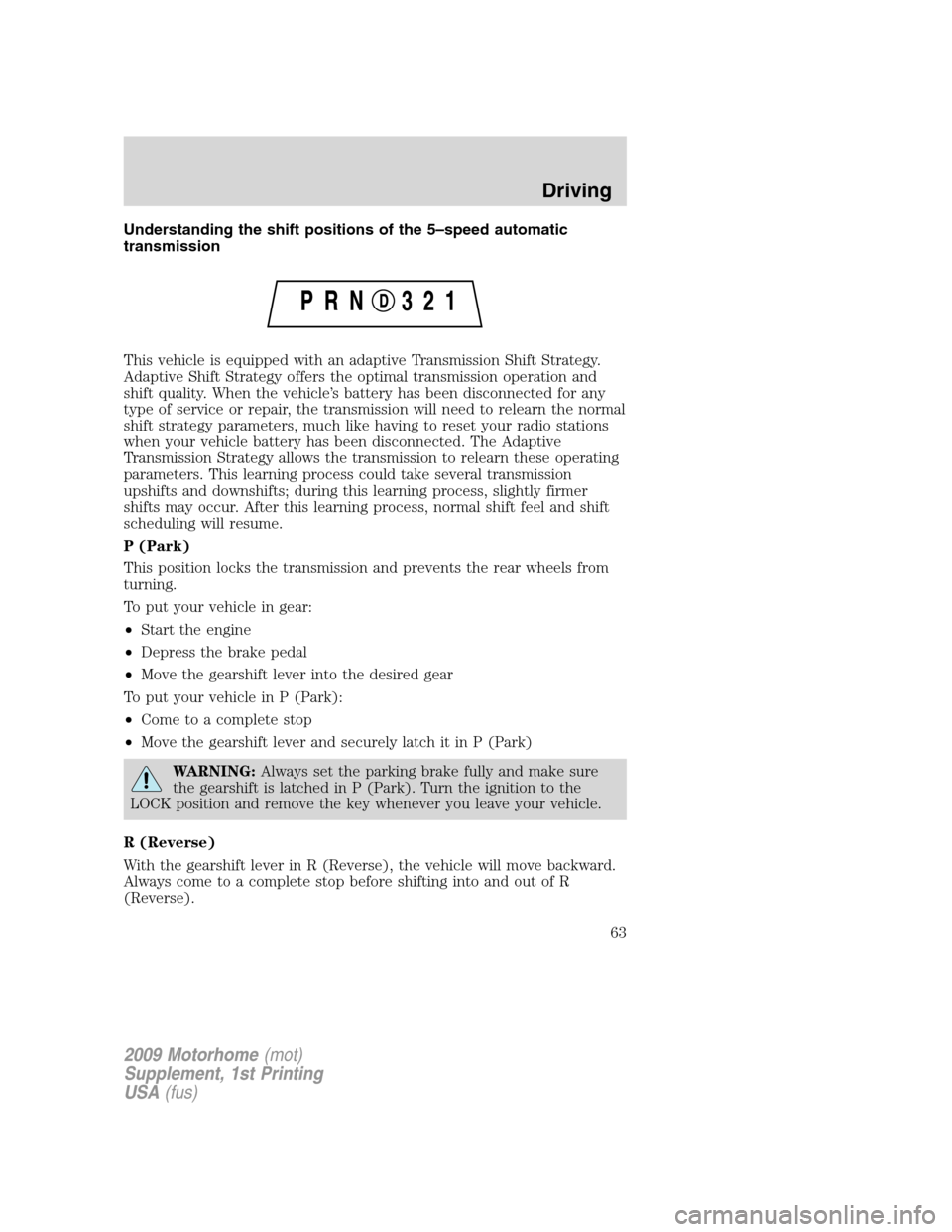
Understanding the shift positions of the 5–speed automatic
transmission
This vehicle is equipped with an adaptive Transmission Shift Strategy.
Adaptive Shift Strategy offers the optimal transmission operation and
shift quality. When the vehicle’s battery has been disconnected for any
type of service or repair, the transmission will need to relearn the normal
shift strategy parameters, much like having to reset your radio stations
when your vehicle battery has been disconnected. The Adaptive
Transmission Strategy allows the transmission to relearn these operating
parameters. This learning process could take several transmission
upshifts and downshifts; during this learning process, slightly firmer
shifts may occur. After this learning process, normal shift feel and shift
scheduling will resume.
P (Park)
This position locks the transmission and prevents the rear wheels from
turning.
To put your vehicle in gear:
•Start the engine
•Depress the brake pedal
•Move the gearshift lever into the desired gear
To put your vehicle in P (Park):
•Come to a complete stop
•Move the gearshift lever and securely latch it in P (Park)
WARNING:Always set the parking brake fully and make sure
the gearshift is latched in P (Park). Turn the ignition to the
LOCK position and remove the key whenever you leave your vehicle.
R (Reverse)
With the gearshift lever in R (Reverse), the vehicle will move backward.
Always come to a complete stop before shifting into and out of R
(Reverse).
2009 Motorhome(mot)
Supplement, 1st Printing
USA(fus)
Driving
63
Page 64 of 136
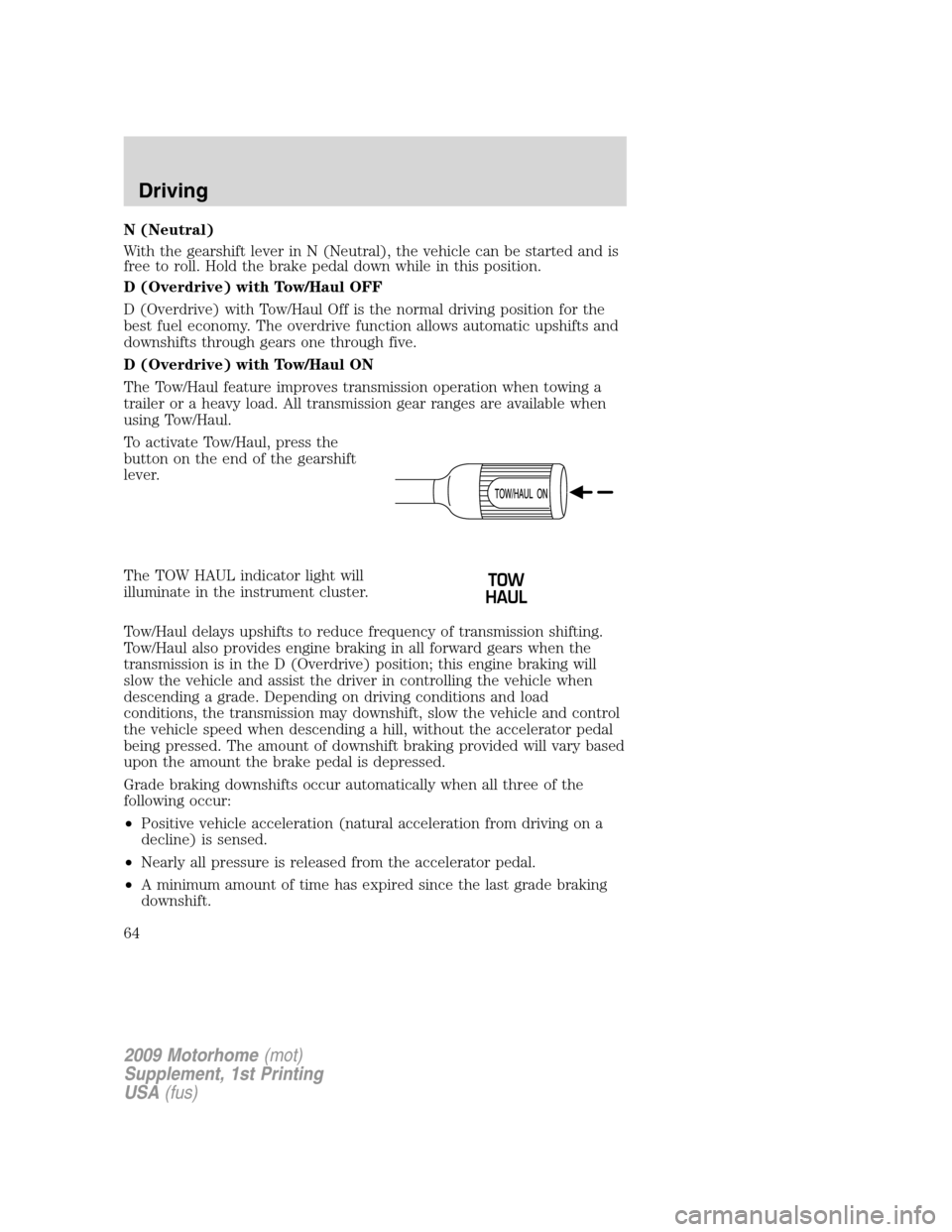
N (Neutral)
With the gearshift lever in N (Neutral), the vehicle can be started and is
free to roll. Hold the brake pedal down while in this position.
D (Overdrive) with Tow/Haul OFF
D (Overdrive) with Tow/Haul Off is the normal driving position for the
best fuel economy. The overdrive function allows automatic upshifts and
downshifts through gears one through five.
D (Overdrive) with Tow/Haul ON
The Tow/Haul feature improves transmission operation when towing a
trailer or a heavy load. All transmission gear ranges are available when
using Tow/Haul.
To activate Tow/Haul, press the
button on the end of the gearshift
lever.
The TOW HAUL indicator light will
illuminate in the instrument cluster.
Tow/Haul delays upshifts to reduce frequency of transmission shifting.
Tow/Haul also provides engine braking in all forward gears when the
transmission is in the D (Overdrive) position; this engine braking will
slow the vehicle and assist the driver in controlling the vehicle when
descending a grade. Depending on driving conditions and load
conditions, the transmission may downshift, slow the vehicle and control
the vehicle speed when descending a hill, without the accelerator pedal
being pressed. The amount of downshift braking provided will vary based
upon the amount the brake pedal is depressed.
Grade braking downshifts occur automatically when all three of the
following occur:
•Positive vehicle acceleration (natural acceleration from driving on a
decline) is sensed.
•Nearly all pressure is released from the accelerator pedal.
•A minimum amount of time has expired since the last grade braking
downshift.
2009 Motorhome(mot)
Supplement, 1st Printing
USA(fus)
Driving
64
Page 66 of 136
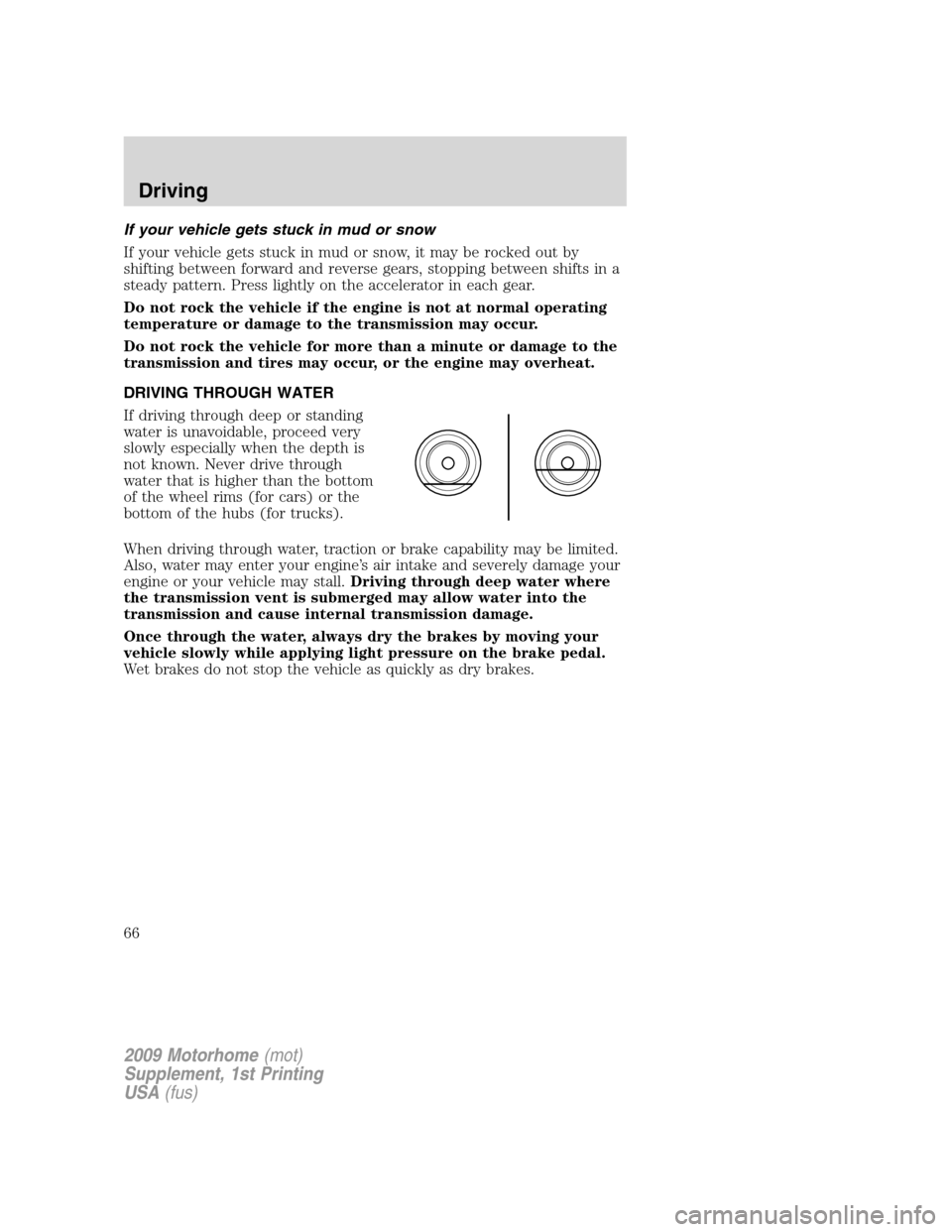
If your vehicle gets stuck in mud or snow
If your vehicle gets stuck in mud or snow, it may be rocked out by
shifting between forward and reverse gears, stopping between shifts in a
steady pattern. Press lightly on the accelerator in each gear.
Do not rock the vehicle if the engine is not at normal operating
temperature or damage to the transmission may occur.
Do not rock the vehicle for more than a minute or damage to the
transmission and tires may occur, or the engine may overheat.
DRIVING THROUGH WATER
If driving through deep or standing
water is unavoidable, proceed very
slowly especially when the depth is
not known. Never drive through
water that is higher than the bottom
of the wheel rims (for cars) or the
bottom of the hubs (for trucks).
When driving through water, traction or brake capability may be limited.
Also, water may enter your engine’s air intake and severely damage your
engine or your vehicle may stall.Driving through deep water where
the transmission vent is submerged may allow water into the
transmission and cause internal transmission damage.
Once through the water, always dry the brakes by moving your
vehicle slowly while applying light pressure on the brake pedal.
Wet brakes do not stop the vehicle as quickly as dry brakes.
2009 Motorhome(mot)
Supplement, 1st Printing
USA(fus)
Driving
66
Page 75 of 136
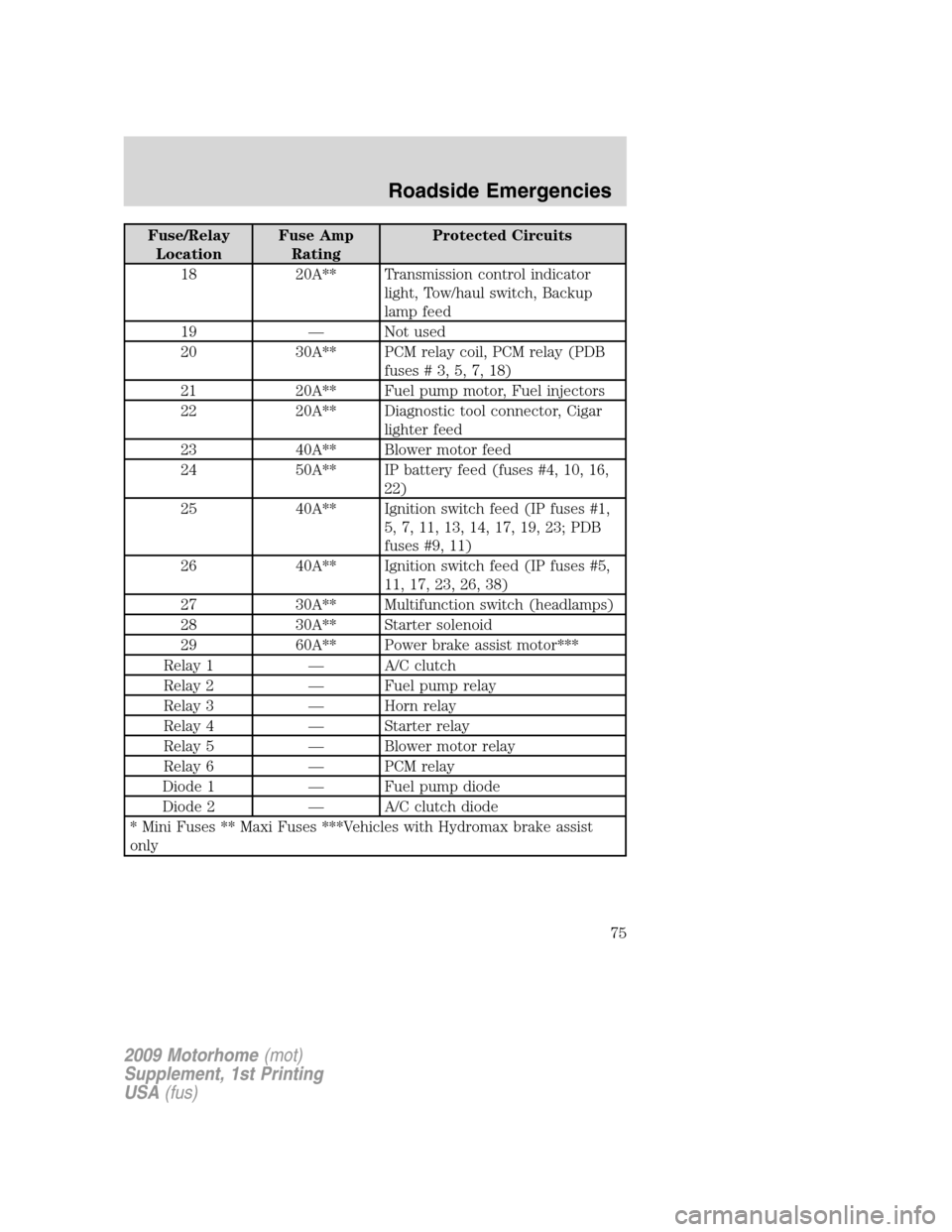
Fuse/Relay
LocationFuse Amp
RatingProtected Circuits
18 20A** Transmission control indicator
light, Tow/haul switch, Backup
lamp feed
19 — Not used
20 30A** PCM relay coil, PCM relay (PDB
fuses#3,5,7,18)
21 20A** Fuel pump motor, Fuel injectors
22 20A** Diagnostic tool connector, Cigar
lighter feed
23 40A** Blower motor feed
24 50A** IP battery feed (fuses #4, 10, 16,
22)
25 40A** Ignition switch feed (IP fuses #1,
5, 7, 11, 13, 14, 17, 19, 23; PDB
fuses #9, 11)
26 40A** Ignition switch feed (IP fuses #5,
11, 17, 23, 26, 38)
27 30A** Multifunction switch (headlamps)
28 30A** Starter solenoid
29 60A** Power brake assist motor***
Relay 1 — A/C clutch
Relay 2 — Fuel pump relay
Relay 3 — Horn relay
Relay 4 — Starter relay
Relay 5 — Blower motor relay
Relay 6 — PCM relay
Diode 1 — Fuel pump diode
Diode 2 — A/C clutch diode
* Mini Fuses ** Maxi Fuses ***Vehicles with Hydromax brake assist
only
2009 Motorhome(mot)
Supplement, 1st Printing
USA(fus)
Roadside Emergencies
75
Page 83 of 136
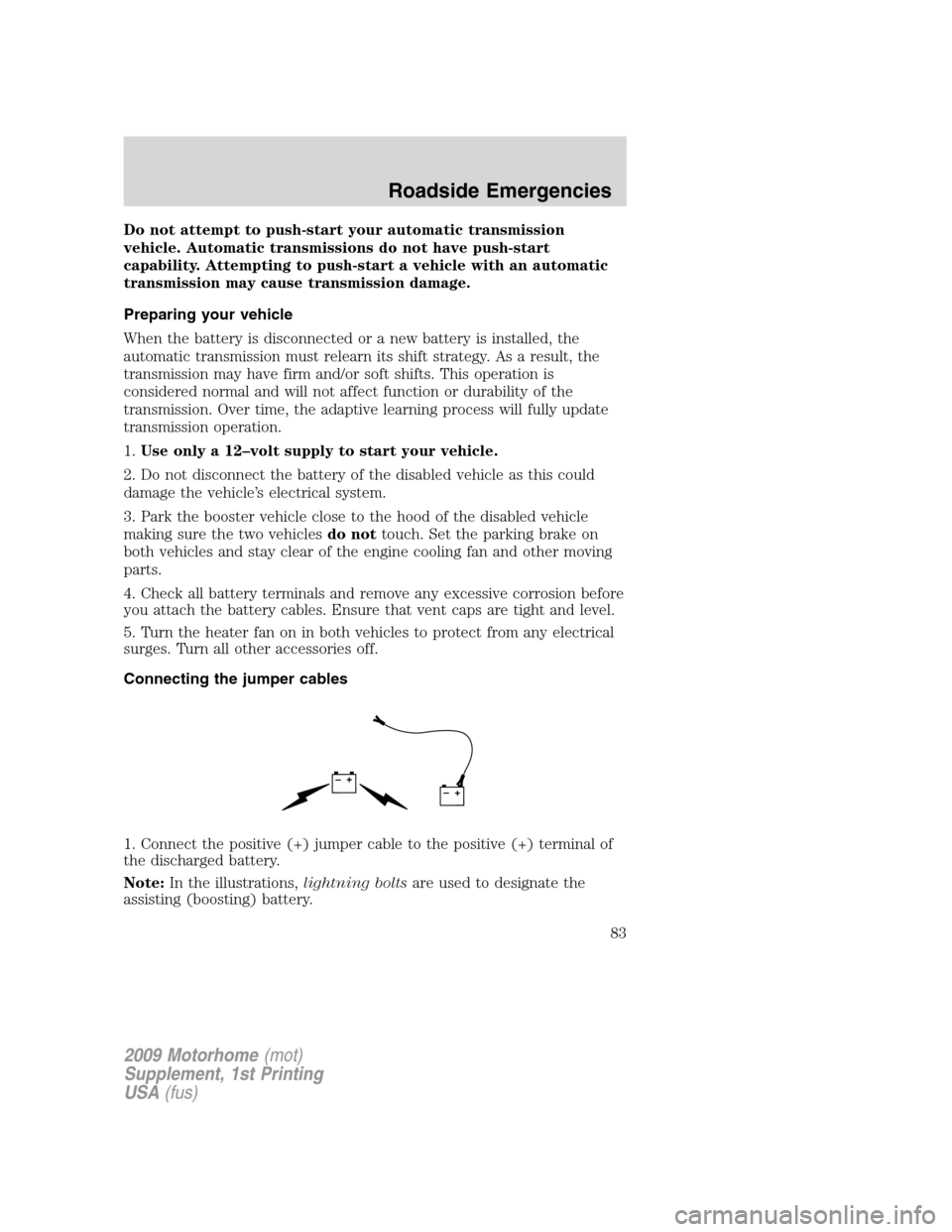
Do not attempt to push-start your automatic transmission
vehicle. Automatic transmissions do not have push-start
capability. Attempting to push-start a vehicle with an automatic
transmission may cause transmission damage.
Preparing your vehicle
When the battery is disconnected or a new battery is installed, the
automatic transmission must relearn its shift strategy. As a result, the
transmission may have firm and/or soft shifts. This operation is
considered normal and will not affect function or durability of the
transmission. Over time, the adaptive learning process will fully update
transmission operation.
1.Use only a 12–volt supply to start your vehicle.
2. Do not disconnect the battery of the disabled vehicle as this could
damage the vehicle’s electrical system.
3. Park the booster vehicle close to the hood of the disabled vehicle
making sure the two vehiclesdo nottouch. Set the parking brake on
both vehicles and stay clear of the engine cooling fan and other moving
parts.
4. Check all battery terminals and remove any excessive corrosion before
you attach the battery cables. Ensure that vent caps are tight and level.
5. Turn the heater fan on in both vehicles to protect from any electrical
surges. Turn all other accessories off.
Connecting the jumper cables
1. Connect the positive (+) jumper cable to the positive (+) terminal of
the discharged battery.
Note:In the illustrations,lightning boltsare used to designate the
assisting (boosting) battery.
+–+–
2009 Motorhome(mot)
Supplement, 1st Printing
USA(fus)
Roadside Emergencies
83
Page 133 of 136
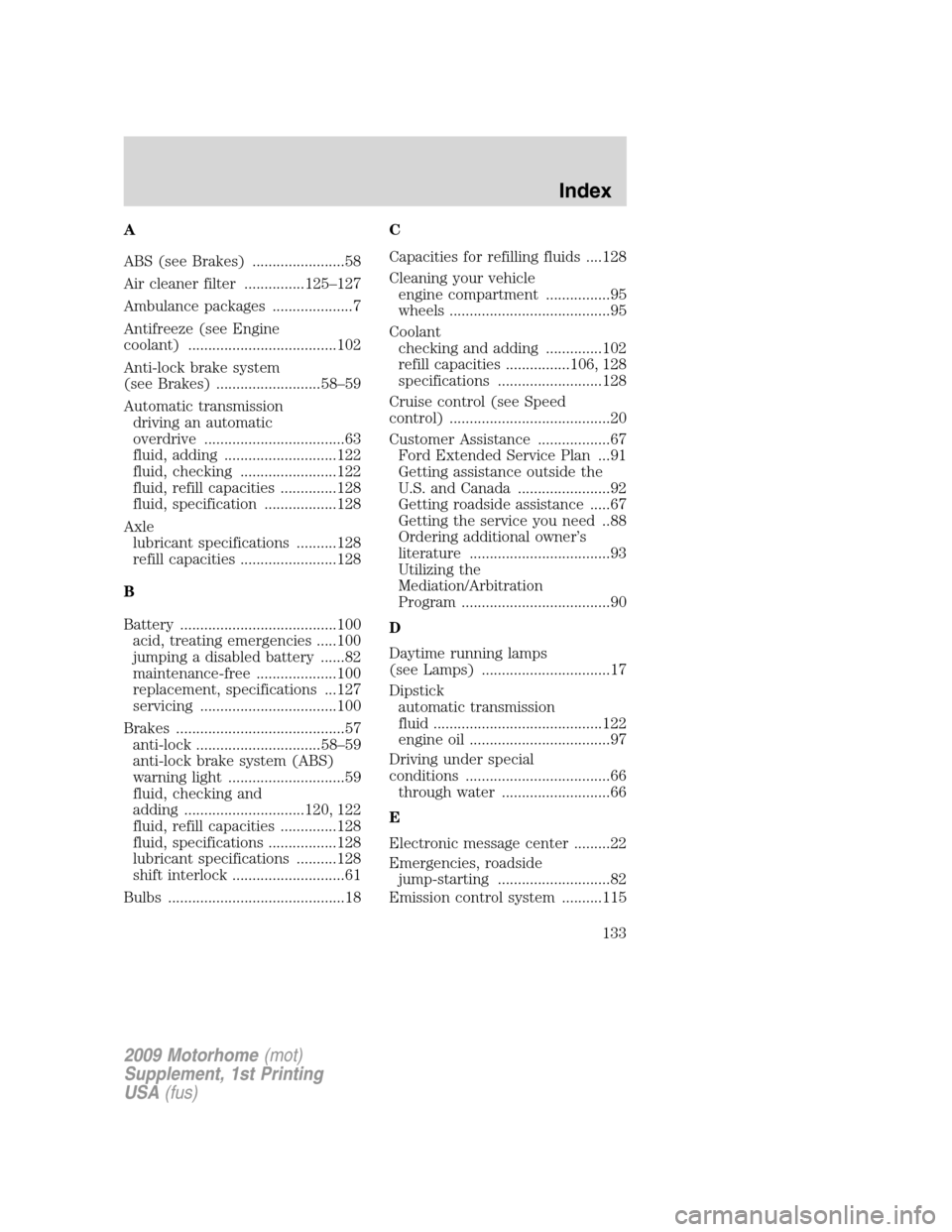
A
ABS (see Brakes) .......................58
Air cleaner filter ...............125–127
Ambulance packages ....................7
Antifreeze (see Engine
coolant) .....................................102
Anti-lock brake system
(see Brakes) ..........................58–59
Automatic transmission
driving an automatic
overdrive ...................................63
fluid, adding ............................122
fluid, checking ........................122
fluid, refill capacities ..............128
fluid, specification ..................128
Axle
lubricant specifications ..........128
refill capacities ........................128
B
Battery .......................................100
acid, treating emergencies .....100
jumping a disabled battery ......82
maintenance-free ....................100
replacement, specifications ...127
servicing ..................................100
Brakes ..........................................57
anti-lock ...............................58–59
anti-lock brake system (ABS)
warning light .............................59
fluid, checking and
adding ..............................120, 122
fluid, refill capacities ..............128
fluid, specifications .................128
lubricant specifications ..........128
shift interlock ............................61
Bulbs ............................................18C
Capacities for refilling fluids ....128
Cleaning your vehicle
engine compartment ................95
wheels ........................................95
Coolant
checking and adding ..............102
refill capacities ................106, 128
specifications ..........................128
Cruise control (see Speed
control) ........................................20
Customer Assistance ..................67
Ford Extended Service Plan ...91
Getting assistance outside the
U.S. and Canada .......................92
Getting roadside assistance .....67
Getting the service you need ..88
Ordering additional owner’s
literature ...................................93
Utilizing the
Mediation/Arbitration
Program .....................................90
D
Daytime running lamps
(see Lamps) ................................17
Dipstick
automatic transmission
fluid ..........................................122
engine oil ...................................97
Driving under special
conditions ....................................66
through water ...........................66
E
Electronic message center .........22
Emergencies, roadside
jump-starting ............................82
Emission control system ..........115
2009 Motorhome(mot)
Supplement, 1st Printing
USA(fus)
Index
133
Page 135 of 136
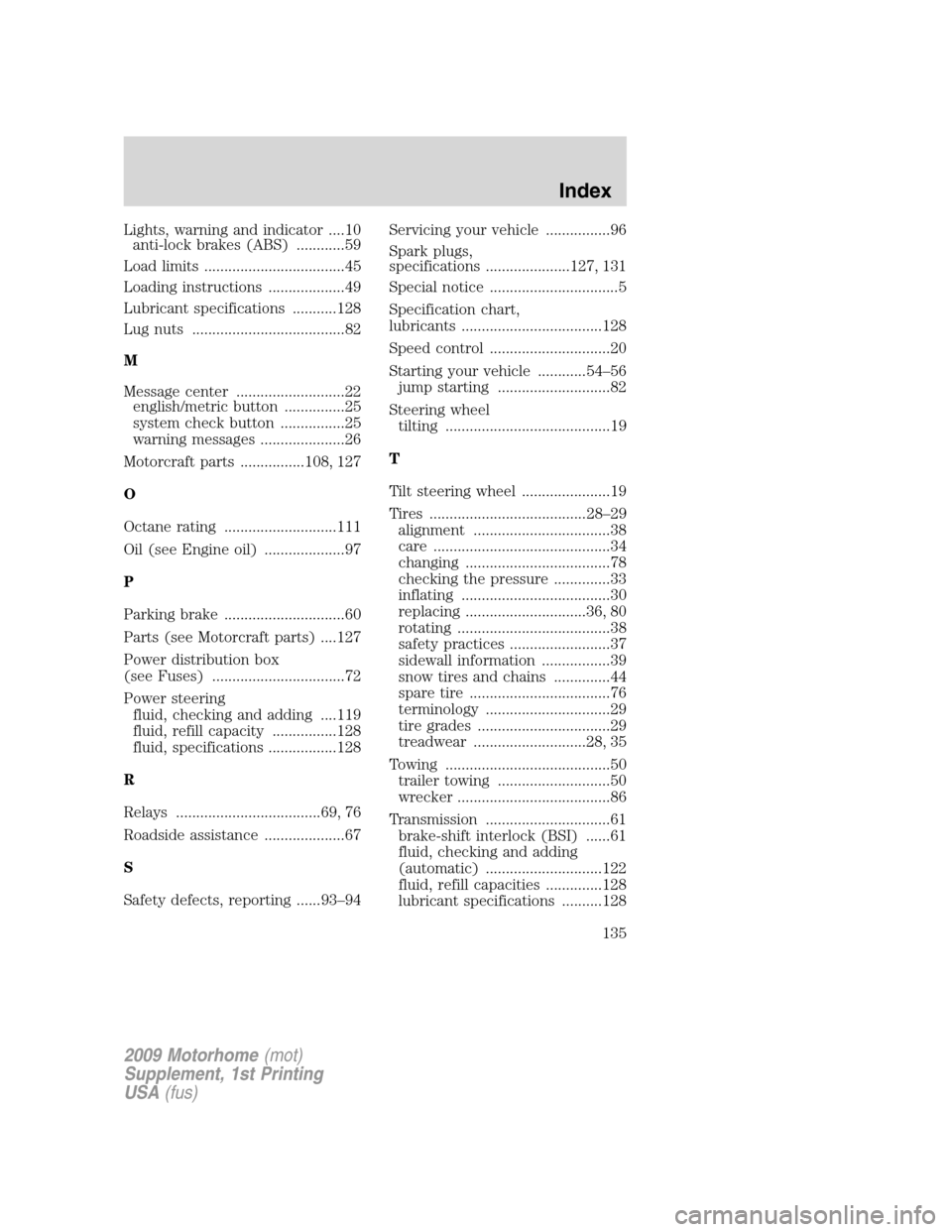
Lights, warning and indicator ....10
anti-lock brakes (ABS) ............59
Load limits ...................................45
Loading instructions ...................49
Lubricant specifications ...........128
Lug nuts ......................................82
M
Message center ...........................22
english/metric button ...............25
system check button ................25
warning messages .....................26
Motorcraft parts ................108, 127
O
Octane rating ............................111
Oil (see Engine oil) ....................97
P
Parking brake ..............................60
Parts (see Motorcraft parts) ....127
Power distribution box
(see Fuses) .................................72
Power steering
fluid, checking and adding ....119
fluid, refill capacity ................128
fluid, specifications .................128
R
Relays ....................................69, 76
Roadside assistance ....................67
S
Safety defects, reporting ......93–94Servicing your vehicle ................96
Spark plugs,
specifications .....................127, 131
Special notice ................................5
Specification chart,
lubricants ...................................128
Speed control ..............................20
Starting your vehicle ............54–56
jump starting ............................82
Steering wheel
tilting .........................................19
T
Tilt steering wheel ......................19
Tires .......................................28–29
alignment ..................................38
care ............................................34
changing ....................................78
checking the pressure ..............33
inflating .....................................30
replacing ..............................36, 80
rotating ......................................38
safety practices .........................37
sidewall information .................39
snow tires and chains ..............44
spare tire ...................................76
terminology ...............................29
tire grades .................................29
treadwear ............................28, 35
Towing .........................................50
trailer towing ............................50
wrecker ......................................86
Transmission ...............................61
brake-shift interlock (BSI) ......61
fluid, checking and adding
(automatic) .............................122
fluid, refill capacities ..............128
lubricant specifications ..........128
2009 Motorhome(mot)
Supplement, 1st Printing
USA(fus)
Index
135